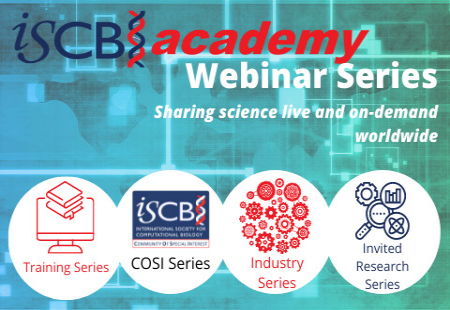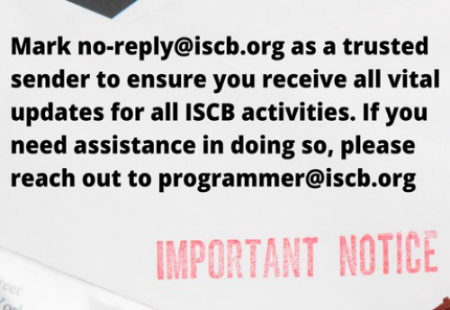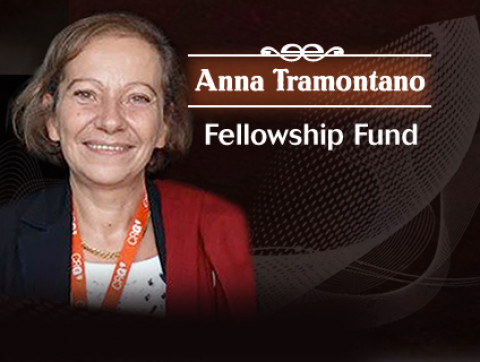SIGs & Satellite Meetings
ISMB/ECCB 2011 will hold a number of one, two and three-day specialized meetings in computational biology. These meetings consist of Special Interest Group Meetings (SIGs) and Satellite Meetings (SMs) and will be held prior to the main conference. A SIG meeting is a one- or two-day focused workshop. It provides a broad and/or deep perspective on developments in a field of research, and is intended as a way to address a topic more extensively than can be done in the main conference. A Satellite Meeting is similar to a SIG meeting but is more of a mini-conference and is generally two or three days in duration. Satellite meetings are held in conjunction with ISMB/ECCB.
Program information and registration details are noted below. To inquire about the possibility of forming a new SIG for ISMB 2012 or beyond, please address your inquiry to This email address is being protected from spambots. You need JavaScript enabled to view it.
3Dsig:Structural Bioinformatics & Computational Biophysics
Date: Friday, July 15 - Saturday, July 16, 2011
Day 1 Start time: 9:00 a.m. End time: 5:30 p.m.
Day 1 Dinner/Keynote*: Start time: 6:30 pm. - 9:00 p.m.
Day 2 Start time: 9:00 a.m. End time: 6:30 p.m.
Location: Austria Center Vienna
Room: Hall E1
*Friday, July 15 - 3Dsig Dinner and Evening Presentation included in 3Dsig Satellite Meeting registration
6:30 p.m. Reception (Cash bar)
7:30 p.m. Dinner
3Dsig, a Satellite Meeting of the ISMB/ECCB conference, focused on structural bioinformatics and computational biophysics and has become the largest meeting in this growing field.
Confirmed Keynotes:
Christine Orengo, University College, London
Ruth Nussinov, Center for Cancer Research, Nanobiology Program
Manfred Sippl, Center of Applied Molecular Engineering, University of Salzburg
Torsten Schwede, Swiss Institute of Bioinformatics, University of Basel
Janet Thornton EBI
Dmitrij Frishman TU-Munchen
Mark Sansom Oxford University
Rebecca Wade EMBL-Heidelberg
More Keynotes to come!
In addition to keynotes our diverse program will include talks selected from submitted abstracts, our traditional after dinner speaker, daily discussion on important topics to this community, laptop software demos and poster sessions. Simply put, 3DSIG is the most comprehensive conference in the field and should not be missed by anyone using macromolecular structure to computationally unravel the mysteries of living systems.
Relevant topics include:
- Application of structure to systems biology
- Structure-based drug discovery including polypharmacology and network pharmacology
- Structure representation, classification and predication
- Macromolecular assembles
- Structural genomics
- 3D databases and data mining
- Molecular visualization
- Relevant methods of structure determination, particularly hybrid methods
- Structure-based function prediction
- Evolution studied through structures
- Docking, analysis, prediction and simulation of biomolecular interactions such as protein-protein, protein-ligand and protein-nucleic-acid
- Prediction and analysis of protein domains
- Membrane protein structure analysis and prediction
- Protein dynamics and disorder
- The structural basis of immunology
We look forward to meeting you at 3Dsig
Program Chair
Philip E. Bourne
University of California San Diego
This email address is being protected from spambots. You need JavaScript enabled to view it.
Rafael Najmanovich
Université de Sherbrooke, Canada
This email address is being protected from spambots. You need JavaScript enabled to view it.
Ilan Samish
The Weizmann Institute
This email address is being protected from spambots. You need JavaScript enabled to view it.
top
CAMDA 2011 – Critical Assessment of Massive Data Analysis
URL:
www.camda.info Date: Friday, July 15 – Saturday, July 16
Start time: 8:30 a.m. - 6:00 p.m.
Location: Austria Center Vienna
Room: A441
We cordially invite you to attend this year's CAMDA.
CAMDA was founded in 2000 to provide a forum for the critical assessment of different techniques used in large-scale data analysis in the life-sciences, such as for high-dimensional gene expression profiling. It aims to establish the state-of-the-art in analysis methods, as well as identify progress and highlight promising directions for future efforts. To this end, CAMDA adopted the approach of a community-wide contest, with the scientific community analysing the same data sets. Researchers worldwide are invited to take the CAMDA challenge, which has become a prominent fixture (cf. Nature Methods 5, 569). Accepted contributions are presented though talks and posters, and the results and methods of the different analyses are discussed and compared at the conference. Typically, well over 100 scientists join us each year.
As a special opportunity this time, we consider the integrated analysis of a particularly rich structured data set that includes gene and miRNA expression, DNA SNPs, copy number variation, and methylation for about 500 matched samples (see Contest pages).
Keynotes by leading researchers in the field provide further focus points for discussion, with both experimental and theoretical issues covered (recent keynote speakers include Mark Gerstein, Eran Segal, John Quackenbush, and Sandrine Dudoit). This year, we already have confirmed contributions by a number of renowned scientists including Terry Speed.
Included in the CAMDA registration is a trip to a local
Heuriger country style restaurant/pub owned by the City of Vienna in the lush vineyards just outside town (
Weingut Cobenzl).
CAMDA was founded by Simon Lin and Kimberly Johnson at Duke University (Nature 411, 885. Nature 424, 610). In 2006 CAMDA became a roving conference, with recent venues including Valencia and Chicago. This year, we will host CAMDA in Vienna. For the first time, the conference is run as an official Satellite meeting of ISMB/ECCB.
Key dates:
| Extended Abstract Proposals Due |
23 May 2011 |
| Abstract deadline for Poster Submission |
23 May 2011 |
| Notification of accepted contributions |
30 May 2011 |
Early registration closes
|
3 Jun 2011 |
| Full paper due for proceedings (post meeting) |
16 Aug 2011 |
Organizers:
top
Fifth International Workshop on Machine Learning in Systems Biology (MLSB 2011)
End Time Wednesday: 5:30 p.m.
End Time Thursday: 4:30 p.m.
Location: Hilton Vienna - Stadtpark Room: Klimt Ballroom 1
Hilton Hotels Wien
Am Stadtpark 1
A-1030 Wien
Molecular biology and all the biomedical sciences are undergoing a revolution as a result of improved sensorics. This has resulted in the ability to study biological processes in unprecedented detail, with exploding fields sharing the "-omics" suffix in their name. These include in particular epigenomics, genomics, transcriptomics, proteomics and metabolomics, devoted respectively to the examination of the entire systems of the epigenome, genes, transcripts, proteins and metabolites present in a given cell or tissue type. The availability of these new data sources for biological exploration is changing the way research in quantitative biology proceeds. In terms of sheer numbers we are presented with a large amount of data about the operation of an individual cell (with high throughput sequencing terabytes of information). However, given the complexity of the underlying systems, decoding the interactions between all the components within the biological system is still a massive challenge. Machine learning naturally appears as one of the main drivers of progress in this context, where most of the targets of interest deal with complex structured objects: sequences, 2D and 3D structures or interaction networks. Machine learning also offers the promise of combining disparate data sources to gain a better overall picture of the biological system. The MLSB workshop is focussed on the interface between machine learning and systems biology, topics of interest include learning with structured data, graph inference, semi-supervised learning, system identification, and novel combinations of optimization and learning algorithms.
Important Dates:
Submission deadline (4 pages, Springer style): May 2, 2011
Notification: May 26, 2011
Poster submissions will also be possible in June and July 2011.
For details on the submission procedure, please take a look at
the upcoming workshop website.
Program Chairs:
Stefan Kramer
Technische Universität München
This email address is being protected from spambots. You need JavaScript enabled to view it.
http://wwwkramer.in.tum.de/kramer/stefan.html
Neil Lawrence
University of Sheffield
This email address is being protected from spambots. You need JavaScript enabled to view it.
http://staffwww.dcs.shef.ac.uk/people/N.Lawrence/
top
3rd RECOMB Bioinformatics Education (RECOMB-BE 2011) Conference and Meeting of the “Bioinformatics for Biologists” Alliance
Date: Wednesday, July 20 & Thursday, July 21
Start time: Wednesday, July 20: 8:30 a.m. - End time: 7:00 p.m.
Start time: Thursday, July 21: 8:30 a.m. - End time: 1:00 p.m.
Room Location: Klimt Ballroom 3
Hilton Hotels Wien
Am Stadtpark 1
A-1030 Wien
The Third Annual RECOMB Conference on Bioinformatics Education (RECOMB-BE) will be held in Vienna, Austria, July 20-21, 2011 as an ISMB/ECCB 2011 (
http://www.iscb.org/ismbeccb2011) satellite meeting. The conference follows the first two RECOMB-BE meetings:
http://casb.ucsd.edu/bioed/ and
http://casb.calit2.net/bioed10/ . RECOMB-BE 2011 will consist of invited presentations, oral presentations selected from submitted abstracts and papers, a poster session, and discussion panels, all of which focus on improving bioinformatics education.
Invited speakers
Partial List: Laurie Heyer (Davidson College), Larry Hunter (University of Colorado), Fran Lewitter (Whitehead Institute for Biomedical Research), Ran Libeskind-Hadas (Harvey Mudd College), Florian Markovetz (Cambridge Research Institute), Bernard Moret (École Polytechnique Fédérale de Lausanne), Tal Pupko (Tel Aviv University), Pavel Pevzner (University of California at San Diego), Ben Raphael (Brown University), Ron Shamir (Tel Aviv University), Beth Simon (University of California at San Diego), Terry Speed (University of California at Berkeley), and Jens Stoye (University of Bielefeld).
Theme and Scope
The goal of RECOMB-BE is threefold: to showcase best practices of teaching bioinformatics ideas to biology undergraduates, to discuss existing challenges in bioinformatics education (with an emphasis on undergraduate education), and to promote collaboration among educators with the aim to develop a mature bioinformatics curriculum. In keeping with the focus on undergraduates, the conference will also showcase selected bioinformatics research projects conducted by undergraduate students.
While biology has been transformed into a computational science in the last decade, the biological curriculum remains largely unchanged with respect to computational issues. The question: “How should we teach bioinformatics to biology students?” has become of the utmost importance, since many universities have not only founded undergraduate bioinformatics programs but are considering the addition of new computational courses to the standard biology curriculum—a change which would represent a dramatic paradigm shift in biology education. However, as the first two RECOMB-BE meetings demonstrated, there is a great divide in how even the world’s top bioinformaticians thought the subject should be taught, and therefore the above pedagogical question has not been answered satisfactorily to date.
RECOMB-BE therefore aims to demonstrate the intricacy, practicality, and beauty of modern bioinformatics at the undergraduate level, and advance the discussion about its curriculum in the biology classroom. For a summary of RECOMB-BE discussions and the educational challenges that lie ahead for bioinformatics, see
Computing has changed biology--biology education must catch up (
Science 2009, v.325: 541-542).
Format
RECOMB-BE will have a somewhat unusual format, inspired by the biennial mathematical conference called Gathering for Gardner (G4G) At G4G, leading mathematicians give high-school and undergraduate level lectures; the goal of G4G is therefore to present complex mathematical ideas in a simple form. This objective is one for which the bioinformatics community must also strive in order to establish meaningful future collaborations with biologists and to bridge the cultural gap between computational and experimental scientists.
Unlike previous meetings on bioinformatics education, which have focused on how bioinformatics should be taught, RECOMB-BE showcases how leading bioinformaticians actually teach. Speakers will give short, introductory-level lectures, aimed at undergraduates. These lectures will be complemented by discussion panels focusing on existing challenges in bioinformatics education as well as poster presentations given by undergraduate students on their research projects.
"Bioinformatics for Biologists" Textbook Project
The participants of RECOMB-BE in 2009 and 2010 formed the Bioinformatics Education Alliance, a group of sixteen leading bioinformaticians who have recently collaborated to produce a textbook, called
Bioinformatics for Biologists (B4B). The first edition of B4B will be published by Cambridge University Press in the summer of 2011, and test copies will be available at ISMB 2011. Please see the official B4B website for more details:
http://cseweb.ucsd.edu/~ppevzner/B4B/B4B is an open project that will be continuously expanded by new chapters. Therefore, RECOMB-BE invites submissions of proposals for new chapters; accepted chapters will be included in the second edition of B4B which is scheduled for publication in 2012 (see “Important Dates” below).
Call for Participation
We invite submissions in four categories:
- Bioinformatics Education Papers
- Bioinformatics for Biologists Textbook Chapter Proposals
- Bioinformatics Education Abstracts (submitted by educators)
- Undergraduate Bioinformatics Research Abstracts (submitted by undergraduate or first-year graduate students)
Selected papers and abstracts in the first three categories will be invited for either oral or poster presentations. Undergraduate bioinformatics research abstracts will be invited for a poster presentation.
Bioinformatics Education Papers should be submitted via the RECOMB-BE website and must be received by May 5, 2010. Each paper should cover a single biological problem and focus on didactic ways to convey the computational ideas needed to address it. Papers should be self-contained and aimed at advanced undergraduate biology students. Submissions that focus either solely on computational topics or solely on biological topics will not be considered. RECOMB-BE imposes no explicit restrictions on format, length, or notation, as we encourage contributors to choose the style they feel is the most appropriate; however, we anticipate that each contributed paper will be at least 10 pages long.
Authors of selected papers will be invited to submit their paper in the journal PLOS Computational Biology (in the Education Article category) as well as a chapter in the second edition of the Bioinformatics for Biologists textbook, which is described above.
Bioinformatics for Biologists(B4B) Chapter Proposals should be submitted via the RECOMB-BE website and must be received by May 15, 2011. Each submission in this category should constitute a brief description of the proposed chapter. Authors of selected proposals will be invited either for oral or poster presentations at RECOMB-BE 2011. In addition, these authors will be asked to submit a full-length chapter for the second edition of B4B shortly after RECOMB-BE. Proposals should cover a single biological problem and focus on didactic ways to convey the computational ideas needed to address it. Submissions that focus either solely on computational topics or solely on biological topics will not be considered. We anticipate that each chapter proposal will be 1-2 pages long.
Bioinformatics Education Abstracts (submitted by educators) should be submitted via the RECOMB-BE web site and must be received by May 20, 2011. Submissions in this category can discuss practice, challenges, or perspectives in bioinformatics education (e.g., curricula, integration of bioinformatics programs, online courses, etc.) or represent a proposal for a short 20-30 minute introductory lecture aimed at undergraduates. We are specifically looking for lectures that begin with a description of an interesting biological problem, such as "Did we evolve from Neanderthals?" and then show how computational techniques can be used to solve this biological problem. Each abstract should be at most 1 page long.
Undergraduate Bioinformatics Research Abstracts (submitted by undergraduates or first-year graduate students reporting their undergraduate work) should be submitted via the RECOMB-BE website and must be received by May 20, 2011. Each abstract should be at most 1 page long.
Travel Support
RECOMB-BE and the Howard Hughes Medical Institute offer travel support to undergraduate students interested in bioinformatics. All undergraduate students are invited to apply for travel support. RECOMB-BE will have a poster session showcasing undergraduate bioinformatics research, and we encourage undergraduate students interested in participation to submit an undergraduate bioinformatics research abstract. Students who submit abstracts will be given a priority with regards to travel support. First-year graduate students who wish to present their undergraduate work are also welcome to apply for travel support. All applications for travel support should be made via RECOMB-BE website.
In addition to supporting undergraduate students, RECOMB-BE also has limited funds to support authors of accepted RECOMB-BE papers and B4B chapter proposals.
IMPORTANT DATES
| Paper submission deadline: |
May 5, 2011 |
| Notification of paper acceptance: |
May 15, 2011 |
| Bioinformatics for Biologists textbook chapter proposals deadline: |
May 15, 2011 |
| Notification of proposal acceptance: |
May 25, 2011 |
| Abstract submission deadline |
May 20, 2011 |
| Notification of abstract acceptance: |
May 25, 2011 |
| Application for travel support deadline: |
June 5, 2011 |
| Notification of travel support: |
June 15, 2011 |
RECOMB-BE ORGANIZERS
RECOMB-BE was founded by Pavel Pevzner (UCSD) and Ron Shamir (Tel Aviv University) in 2009.
RECOMB-BE 2011 Program Committee: Fran Lewitter (Whitehead Institute for Biomedical Research), Ran Libeskind-Hadas (Harvey Mudd College), Pavel Pevzner, (UCSD) and Ron Shamir (Tel Aviv University).
RECOMB-BE Organizing Committee: Phillip Compeau (Chair), Sangtae Kim, and Son Pham.
E.mail contact: This email address is being protected from spambots. You need JavaScript enabled to view it.
RECOMB-BE SUPPORT
RECOMB-BE is supported by the Howard Hughes Medical Institute (HHMI), the International Society for Computational Biology (ISCB), and the California Institute for Telecommunications and Information Technologies (CalIT2).
About RECOMB
The RECOMB International Conference on Research in Computational Molecular Biology was founded in 1997 to provide a scientific forum for theoretical advances in computational biology and their applications in molecular biology and medicine. The conference arose from the need to advance research on the mathematical and computational side of molecular biology, and today the conference maintains its focus on state-of-the-art computational advances in this field. The 15th Annual RECOMB conference (RECOMB 2011) will be held March 28-31, 2011 in Vancouver, Canada. The conference website can be found at
http://compbio.cs.sfu.ca/recomb2011/.
top
SIG Meetings
Alternative Splicing - Towards an integrated view of RNA biology
URL: http://www.alternative-splicing.org/as-sig-11/
Date: Friday, July 15 - Saturday, July 16
Start time: 8:30 a.m. - End time: 6:00 p.m.
Room Location: Hall O (Austria Center Vienna)
 View FriendFeed Entry
View FriendFeed Entry
Alternative splicing (AS) appears as a highly regulated mechanism that is involved in many biological processes, such as cell type differentiation, sex-determination, or apoptosis. Importantly, defects in either cis-acting regulatory elements or trans-acting factors that mediate AS can lead to aberrant splicing and even human disease.
In addition to AS, other RNA transcription and processing events contribute to significantly expand the transcriptome diversity. These include alternative polyadenylation and the expression of many non-coding RNAs, such as micro-RNAs (miRNAs), small-interfering RNAs (siRNAs), PIWI-interacting RNAs (piRNAs), or long nuclear RNAs. While originally many of these phenomena were studied separately, accumulating evidence now points towards the interplay between transcription, RNA processing, RNA turnover and the effects non-coding RNAs exert on these machineries. This interplay leads to a new, interconnected system view and consequent study of gene expression regulation.
With the advent of high-throughput methodologies researchers have been able to obtain genome-wide information to analyze the make-up and the regulation of the transcriptome within a well-defined biological context. While the depth of new data generation is astonishing and a welcomed development, its complexity also poses interpretation challenges, particularly when considering that the snapshot of the transcriptome that high-throughput methodologies permit us to obtain are the result of many integrated gene expression processes.
In this meeting we aim to provide an opportunity to bring together world experts in the fields of RNA processing, non-coding RNAs, and computation to discuss recent advances highlighting the integrated view of RNA biology with the hope to generate new research ideas to decipher the regulation of RNA processing. Moreover, as these studies rely heavily on clever computational approaches to analyze high-throughput data sets, we expect that the context of the ISMB conference and the participation of computational experts will give rise to fruitful interactions and will provide the basis for building a port for shared resources and tools in this fast developing field.
The AS-SIG look forward to welcoming attendees to a fun filled evening at the Winery Fuhrgassl-Huber in Neustift on Friday, July 15!
Located in the heart of Neustift am Walde between vineyards and the Vienna Woods, this Winery with its cosy parlours and romantic patio has been a popular wine tavern for almost 30 years. In the "Schmiede" we will enjoy the atmosphere of a Viennese wine tavern in a sheltered garden. Winery details here.
Delegates must purchase their ticket for €45+VAT online (available under merchandise) by July 5,2011. Transportation to the winery is included with bus transportation from the Austria Center Vienna. Delegates will return individually or in smaller groups of three to four by cab.
19:00 Depart Austria Center Vienna
19:30 Dinner
21:30 (est) Departure on own
Fuhrgassl-Huber, 1190 Vienna, Neustift/Walde 68
Telephone: +43 (0) 1 440 14 05.
Organizers:
Klemens Hertel
University of California, Irvine, USA
This email address is being protected from spambots. You need JavaScript enabled to view it.
Yoseph Barash
University of Toronto, Canada
This email address is being protected from spambots. You need JavaScript enabled to view it.
Dirk Holste
Institute of Molecular Pathology, Vienna
This email address is being protected from spambots. You need JavaScript enabled to view it.
Eduardo Eyras
Pompeu Fabra University & ICREA, Spain
This email address is being protected from spambots. You need JavaScript enabled to view it.
top
AFP/CAFA: The Automated Function Prediction SIG featuring CAFA: Critical Assessment of Function Annotation
URL: http://biofunctionprediction.org/
Date: Friday, July 15 - Saturday, July 16
Start time: 8:30 a.m. - End time: 6:00 p.m.
Room Location: Hall L (Austria Center Vienna)
 View FriendFeed Entry
View FriendFeed Entry
The deluge of genomic information is challenging biologists to annotate this data, from locating genes in the raw data through to predicting the function from protein sequence and structure. Following the successful meetings of 2005-2008 we have decided to a SIG that will deal with a wide scope of gene, protein, and genomic annotations.
Keynote speakers:
- Janet Thornton European Bioinformatics Institute
- Amos Bairoch Swiss Institute of Bioinformatics
- Olga Troyanskaya Princeton University
About CAFA
CAFA is a community-driven effort. About 35 research groups predicted the function of a set of proteins whose true function is sequestered. At the meeting, we will reveal the true functions and discuss the predictions. The CAFA challenge goals are to foster a discussion between annotators, predictors and experimentalists about methodology as quality of functional predictions, as well as the methodology of assessing those predictions.
Besides the CAFA challenge, the Automated Function Prediction SIG will also include keynote and contributed talks.
Contributed talks are sought in, but not limited to:
- Function prediction using sequence based methods. This would include "classic" methods such as detection of functional motifs and inferring function from sequence similarity.
- Function from genomic information: prediction by genomic location; locus comparison with other organisms; function gain and loss.
- Phylogeny based methods
- Function from molecular interactions
- Function from structure
- Function prediction using combined methods
- "Meta-talks" discussing the limitations and horizons of computational function prediction.
- Collaboration between experimental and computational biologists in function prediction.
- Assessing function prediction programs
Organizers:
Iddo Friedberg
Miami University, United States
This email address is being protected from spambots. You need JavaScript enabled to view it.
Michal Linial
The Hebrew University of Jerusalem, Israel
This email address is being protected from spambots. You need JavaScript enabled to view it.
Predrag Radivojac
Indiana University, United States
This email address is being protected from spambots. You need JavaScript enabled to view it.
top
The Bio-Ontologies SIG provides a forum for discussion of the latest and most innovative research in the appplication of ontologies and more generally the organisation, presentation and dissemination of knowledge in biomedicine and the life sciences. Bio-Ontologies has existed as a SIG at ISMB for 13 years, making it one of the longest running.
Key Dates
|
| April 22th, 2011 |
Submissions Due |
| |
| May 13th, 2011 |
Notifications |
| |
| May 20th, 2011 |
Final Version Due |
| |
| July 15th-16th, 2011 |
Workshop |
| |
|
We are interested in innovative approaches to organising, presenting and consuming knowledge in life sciences and biomedicine. We invite papers in traditional areas, such as the biological applications of ontologies, reports on newly developed Bio-Ontologies, and the use of ontologies in data sharing standards. In addition, we invite submissions on methods, applications and workflows that "bridge the gaps" in the acquisition, dissemination and consumption of scientific content in biomedical informatics research.
We are inviting three types of submissions.
- Short papers, up to 4 pages.
- Poster abstracts, up to 1 page.
- Flash updates, up to 1 page
Following review, successful papers will be presented at the Bio-Ontologies SIG. Poster abstracts will be provided poster space and time will be allocated during the 2 days for at least one poster session. Flash updates are for short talks (5 min) giving the salient new developments on existing public ontologies. Authors of posters can also indicate a desire to provide a flash update.
Organizers:
Nigam Shah, Stanford University, USA
This email address is being protected from spambots. You need JavaScript enabled to view it.
Susanna-Assunta Sansone, University of Oxford, Oxford e-Research Center, UK
This email address is being protected from spambots. You need JavaScript enabled to view it.
Susie M Stephens, Johnson & Johnson Pharmaceutical Research & Development, USA
This email address is being protected from spambots. You need JavaScript enabled to view it.
Larisa Soldatova, University of Aberswyth, UK
This email address is being protected from spambots. You need JavaScript enabled to view it.
top
BioReg SIG: Bioinformatics for Regulatory Genomics
URL: http://light.ece.ohio.edu/bioreg/2011/
Date: Saturday, July 16
Start time: 8:30 a.m. - End time: 6:00 p.m.
Room Location: Hall N (Austria Center Vienna)
 View FriendFeed Entry
View FriendFeed Entry
Regulatory genomics involves the study of the genomic ‘control system,’ which determines how, when and where to activate the ‘blueprint’ encoded in the genome. Regulatory genomics is the topic of much research activity worldwide. Since computational methods are important in the study of gene regulation, we propose to continue BioRegSIG, an ISMB special interest group that focuses on bioinformatics for regulatory genomics. An important goal of the SIG is to foster a collaborative community wherein scientists convene to solve difficult research problems in all areas of computational regulatory genomics.
At BioRegSIG-2010, researchers considered the problem of “pattern discovery for prediction/identification of functional elements in sequenced genomes.” BioRegSIG-2011 will be broadened to include other topics that are important in regulatory genomics research. Specifically, we envision sessions and plenary talks that address the following topics:
- epigenetic analysis (emerging technologies, large scale data handling, applications)
- pattern discovery for prediction/identification of functional elements in sequenced genomes (algorithms, statistical models, benchmarks and case studies)
- analysis of high-throughput sequencing data in all its applications, including RNA-seq for expression measurement; ChIP-seq for chromatin state; and ChIP-seq for mapping of TFs (including particular cell-type specific TFs)
- miRNAs (including how to predict ncRNA genes and miRNA target sites)
- developing models of TF specificity from various types of high-throughput data
- regulation of alternative splicing
- the role of chromatin structure and histone modifications in the regulation of alternative splicing and in gene regulation (including how to integrate different types of information into TFBS prediction and analysis)
- evolution and genetics of regulation (eQTL analyis)
- elucidating gene regulatory networks and circuits
SIG CHAIRS
- Finn Drablos, Norwegian University of Science and Technology, Norway
- Sophie Schbath, Institut National de la Recherché Agronomique, France
- Lonnie Welch, Ohio University, USA
SIG ORGANIZING COMMITTEE
- Herbert Auer, Institute for Research in Biomedicine, Spain
- Tim Bailey, University of Queensland, Australia
- Laura Elnitski, National Human Genome Research Institute, USA
- Roderic Guigo, Centre for Genomic Regulation, Spain
- Kathleen Marchal, Katholieke Universiteit Leuven, Belgium
- Gerhard Mittler, Max Planck Institute, Germany
- Matias Piipari, Wellcome Trust Sanger Institute, UK
- Daniel J. Quest, Oak Ridge National Laboratory, USA
- Isidore Rigoutsos, Thomas Jefferson University, USA
- Saurabh Sinha, University of Illinois, USA
- Gary Stormo, Washington University, USA
- Weixiong Zhang, Washington University, USA
Organizers (contact):
Finn Drablos
Norwegian University of Science and Technology, Norway
This email address is being protected from spambots. You need JavaScript enabled to view it.
Sophie Schbath
Institut National de la Recherché Agronomique, France
This email address is being protected from spambots. You need JavaScript enabled to view it.
Lonnie Welch
Ohio University, USA
This email address is being protected from spambots. You need JavaScript enabled to view it.
top
BOSC: The 12th Annual Bioinformatics Open Source Conference
URL: http://www.open-bio.org/wiki/BOSC_2011
Date: Friday, July 15 - Saturday, July 16
Start time: 8:30 a.m. - End time: 6:00 p.m.
Room Location: Hall F2 (Austria Center Vienna)
 View FriendFeed Entry
View FriendFeed Entry
The Bioinformatics Open Source Conference (BOSC) is sponsored by the Open Bioinformatics Foundation (O|B|F), a non-profit group dedicated to promoting the practice and philosophy of Open Source software development within the biological research community. Many open source bioinformatics packages are widely used by the research community across a wide range of application areas. They form a cornerstone in enabling research in the genomic and post-genomic era. Open source bioinformatics software has facilitated rapid innovation, dissemination, and wide adoption of new computational methods, reusable software components, and standards. The sessions planned for BOSC 2011 include:
-
Approaches to parallel processing -- This session will cover data-parallel approaches to analyzing the massive data sets from next-generation sequencing and mass spec proteomics, or reports on the parallelization of bioinformatics algorithms in general.
-
Cloud-based approaches to improving software and data accessibility -- The emergence of cloud computing has made highly scalable cluster computing available to computational biologists. Services such as Amazon Elastic Compute Cloud combined with publicly available datasets promise to lower the overhead to participate in large scale data analyses. Talks will focus on how the community can build up resources and datasets for cloud infrastructure, as well as the sharing of insights, and the contribution of implemented workflows.
-
The Semantic Web in open source bioinformatics -- Software that employs semantic web technology: Existing databases such as UniProt are now being made fully available in RDF format, and new repositories such as Bio2RDF are being built upon RDF and are allowing RDF-based query language use (e.g., SPARQL). This session is devoted to reports on software that works with such new data stores, or aids in their development, as well as descriptions of software that pertains to ontology building or maintenance. We also solicit talks about projects that employ information management architectures/frameworks such as UIMA, an open source project in Apache Incubator status, that facilitate integration of semantic analysis and search components.
-
Genome content management -- Processes and technologies that support the creating, managing and reporting of genomic data. This session is appropriate for discussion of systems that involve components such as (but not limited to) Ensembl and GMOD/Chado data stores, Taverna and Galaxy analysis workflows, and BioMart and InterMine warehouses.
-
Data visualization-- Approaches to presenting large biomedical datasets with visual aids that make the data easier to understand and analyze.
-
Tools for next-generation sequencing -- Practical approaches to analyzing next generation sequencing data, focusing on flexible tools that combine existing software and algorithms.
-
Meeting the challenges of inter-institutional collaboration (panel discussion) -- Many open source projects involve collaborators from organizations all over the world. Participants in this panel discussion will comment on how their projects have dealt with the challenges that arise from these multi-institution collaborations.
Keynote speakers (as of March 7, 2011):
Lawrence Hunter
Lawrence Hunter is Professor of Pharmacology and Computer Science at the University of Colorado and director of the Computational Bioscience Program at the School of Medicine. He is one of the founders of ISMB, a fellow of the ISCB, and well known for contributions in a broad range of problems in computational biology. Dr. Hunter will be giving a talk entitled The role of openness in knowledge-based systems for biomedicine.
Matt Wood
As the Technology Evangelist for Amazon Web Services, Matt discusses the technical and organisational aspects of cloud computing across the world. With a background in the life sciences, Matt is interested in helping teams of all sizes bring their ideas to life through technology. Before joining Amazon he built web-scale search engines at Cornell University, sequenced DNA in Hinxton and developed scientific software in Cambridge. He is a frequent speaker at international conferences, a blogger, published author and an advocate of research productivity. Matt's talk, entitled Into the Wonderful, will feature a discussion of the constraints of working with the size, scope and complexity of modern research data, and how cloud computing can help accelerate academic research. We'll take a look at the current state of the art, the role cloud computing plays in increasing the impact of open source tools, the use of public hosted data in the cloud and how academic cloud platforms can help promote collaboration, reproducibility and reuse across disciplines.
Please visit our web site at http://www.open-bio.org/wiki/BOSC_2011 for more details about BOSC 2011.
Organizers:
Nomi Harris
Lawrence Berkeley National Laboratory, USA
This email address is being protected from spambots. You need JavaScript enabled to view it. or This email address is being protected from spambots. You need JavaScript enabled to view it.
Peter Rice
European Bioinformatics Institute, UK
This email address is being protected from spambots. You need JavaScript enabled to view it. or This email address is being protected from spambots. You need JavaScript enabled to view it.
top
HiTSEQ 2011: High Throughput Sequencing: Algorithms & Methodologies
URL: hitseq.org
Date: Friday, July 15 - Saturday, July 16
Start time: 8:30 a.m. - End time: 6:00 p.m.
Room Location: Hall F1 (Austria Center Vienna)
 View FriendFeed Entry
View FriendFeed Entry
High Throughput Sequencing is revolutionizing the way biologists generate and analyze biological data. While in the past sequencing was used mainly to characterize individual genomes or transcripts, low-cost high-throughput sequencing can now address a broad range of genetic analysis applications including: comparative genomics, high-throughput polymorphism detection, analysis of coding and non-coding RNAs, identifying mutant genes in disease pathways, and profiling metagenomes. Some of the earlier “high-throughput” technologies, such as Illumina, and ABI SOLiD have compromised read length to increase throughput. Forthcoming, 3rd Generation sequencing technologies are expected to have significantly longer reads, albeit at the cost of high error rates, while maintaining, or increasing the overall throughput.
While the promise of high throughput sequencing (HTS) technologies has become a reality, and computational methods for assembly, alignment, and variation detection using HTS reads are becoming available, there is still significant room to improve. Programs and algorithms developed for Sanger-style reads must be scaled, or completely reinvented to match the characteristics of the HTS data.
These Special Interest Group sessions will be devoted to discussing latest advances in computational techniques for HTS datasets, and will provide a forum for in depth presentations of the methods and discussion among the scientists working in this field.
I. Detecting Genome variation
While the problem of mapping reads to a pre-existing “reference” genome is becoming better understood, better algorithms for discovery of important variants from the mapped reads are still necessary. This session will explore methodology to infer various polymorphisms (SNVs, large insertions/deletions, copy number variations) with HTS data. As the HapMap and now the 1000 Genomes projects have increased our understanding of SNPs, structural variation (including insertions, deletions, translocation, inversions, and CNVs) have come to the forefront as one of the main sources of variation within a species. HTS technologies offer the potential of high resolution detection of structural variants, in particular in cancer genomes, but they will also create a deluge of data, requiring the use of more powerful algorithms. The methods for detecting structural variants using HTS data are a promising research area for the genome analysis community.
II. Transcriptome Analysis
Another exciting application of HTS technologies is RNA sequencing. Here the target sequence is not the genome, but the set of RNA molecules transcribed from the genome. RNA sequencing is currently used for several applications, including RNA expression, de-novo transcriptome sequencing for non-model organisms, and novel (coding and non-coding) transcript discovery, among others. For RNA and micro-RNA expression profiling, HTS has significant advantages compared to microarray methods in that it is better able to identify quantities of very common and very rare transcripts. RNA sequencing also makes possible the discovery of novel transcripts, which do not match any probe on a microarray – an important feature for discovery of novel transcripts, and identification of alternative splicing. Transcriptome profiling is also increasingly used for sequencing the RNA of non-model organisms for phylogenetic and population studies, and methods for transcriptome assembly and co-assembly need to be improved. With sequencing, detection of expressed SNVs and their use to detected allele-specific expression and cis-regulatory elements is also feasible. This, again, is a novel area of algorithmic exploration.
III. Epigenomics and chromatin regulation
HTS Sequencing is also commonly used for discovery of transcription factor binding sites (and nucleosome positioning) using CHiP-seq. In addition, many techniques are appearing to explore the epigenome, including methylation sensitive restriction enzymes, MeD-IP, and bisulfate resequencing. The latter makes the problem of aligning reads much more complex. Thus, novel algorithms will be required to handle these experiments.
IV. Metagenomics.
Another common application of HTS is metagenomics. This ranges from sequencing of environmental samples, to census of microbial flora in disease affected individuals vs. control. We welcome presentations on these topics, as well as any other important methods related to HTS technologies.
V. 3rd Generation Sequencing Technologies
One of the key developments in the HTS field is the emergence of 3rd generation, single molecule sequencing technologies. These promise to enhance the utility of whole genome DNA sequencing and the associated genetic analysis applications by providing longer reads, quicker turnaround times, and valuable kinetic information that enables direct detection of base modifications as part of a sequencing run. The diversity of applications and flexibility of single molecule sequencing technologies will demand novel approaches to modeling sequencing data in order to fully leverage the information (e.g., kinetic information associated with each read) obtained from such platforms. As was the case with other HTS platforms, programs and algorithms developed for Sanger and NGS data will need to be modified or reinvented to match the characteristics of single molecule sequencing data. Managing and organizing the data in ways that facilitate interpretation and data mining applications will also be a challenge.
3. Draft Schedule
Day 1:
9 am – 12 pm Session I, Variation Discovery: Keynote address 1, 7-8 talks
1:30pm - 6 pm Session II, Transcriptomics: ~10 talks
Day 2:
9 am – 12 pm Session III, Epigenetics & Metagenomics: ~10 talks
1:30pm - 4:30 pm Poster Session
5pm – 6pm Keynote address 2
Organizers:
Inanc Birol
British Columbia Cancer Agency, Canada
This email address is being protected from spambots. You need JavaScript enabled to view it.
Michael Brudno
University of Toronto, Canada
This email address is being protected from spambots. You need JavaScript enabled to view it.
Francisco M. De La Vega
San Mateo, United States
This email address is being protected from spambots. You need JavaScript enabled to view it.
Gunnar Rätsch
Max Planck Society, Germany
This email address is being protected from spambots. You need JavaScript enabled to view it.
Jens Stoye
Bielefeld University, Germany
This email address is being protected from spambots. You need JavaScript enabled to view it.
top
Network Biology SIG: On the Analysis and Visualization of Networks in Biology
URL: http://nrnb.org/netbiowiki
Date: Friday, July 15
Start time: 8:30 a.m. - End time: 6:00 p.m.
Room Location: J241 (Austria Center Vienna)
 View FriendFeed Entry
View FriendFeed Entry
Biological networks provide a context for integrating and analyzing massive amounts of diverse kinds of measurement data, such as gene expression data from microarray experiments, protein abundance data from mass spectrometry, and genetic data from association studies. Network theory provides powerful analysis techniques that can be used to develop insights into large amounts of data. Our use of networks in biology has changed from purely representational and didactic purposes to more analytic and hypothesis formulation purposes. This shift has resulted, in part, from the confluence of advances in computation, informatics, and high throughput techniques in systems biology.
For interactions amongst thousands of genes, proteins, and metabolites, these networks can be quite large and complex. Network analysis tools can manage this complexity, for example by identifying clusters of activity – regions of high interconnectivity that are also characterized by high gene expression levels. The most highly connected molecules or hubs of such regions may be control points for the network; modulating their activity may influence the activity of many other molecules. With knowledge of the structure and behavior of biological networks, biologists can identify intervention points for drugs and therapeutics, limit adverse side-effects of treatments, and infer predisposition to disease.
We are soliciting abstracts that cover new developments in network biology. The SIG will focus on two major areas: (1) the development of network-related tools and resources, and (2) the application of network analysis and visualization in the study of biology, synthetic biology and medicine. The SIG will provide a unique interface between tool developers and users in the field of network biology. Through these complementary lenses, the SIG will bring into focus the current state of the field, its future promise and how to get there.
Organizers:
Alexander Pico
David J Gladstone Institutues, USA
This email address is being protected from spambots. You need JavaScript enabled to view it.@This email address is being protected from spambots. You need JavaScript enabled to view it..This email address is being protected from spambots. You need JavaScript enabled to view it..This email address is being protected from spambots. You need JavaScript enabled to view it.
Scooter Morris
University of California, San Francisco, USA
This email address is being protected from spambots. You need JavaScript enabled to view it.@This email address is being protected from spambots. You need JavaScript enabled to view it..This email address is being protected from spambots. You need JavaScript enabled to view it..This email address is being protected from spambots. You need JavaScript enabled to view it.
Allan Kuchinsky
Agilent Technologies, USA
This email address is being protected from spambots. You need JavaScript enabled to view it._This email address is being protected from spambots. You need JavaScript enabled to view it.@This email address is being protected from spambots. You need JavaScript enabled to view it..This email address is being protected from spambots. You need JavaScript enabled to view it.
Annette Adler
Agilent Technologies, USA
This email address is being protected from spambots. You need JavaScript enabled to view it._This email address is being protected from spambots. You need JavaScript enabled to view it.@This email address is being protected from spambots. You need JavaScript enabled to view it..This email address is being protected from spambots. You need JavaScript enabled to view it.
Gary Bader
University of Toronto
This email address is being protected from spambots. You need JavaScript enabled to view it..This email address is being protected from spambots. You need JavaScript enabled to view it.@This email address is being protected from spambots. You need JavaScript enabled to view it..This email address is being protected from spambots. You need JavaScript enabled to view it.
Mario Albrecht
Max Planck Institut
This email address is being protected from spambots. You need JavaScript enabled to view it.
Diego di Bernardo
Telethon Institute of Genetics and Medicine
This email address is being protected from spambots. You need JavaScript enabled to view it.
Ian Donaldson
University of Oslo
This email address is being protected from spambots. You need JavaScript enabled to view it.
Hana El-Samad
University of California at San Francisco
This email address is being protected from spambots. You need JavaScript enabled to view it.
top
SNP-SIG: Identification and annotation of SNPs in the context of structure, function, and disease
URL: http://snps.uib.es/snp-sig/
Date: Friday, July 15
Start time: 8:30 a.m. - End time: 6:00 p.m.
Room Location: Hall N (Austria Center Vienna)
 View FriendFeed Entry
View FriendFeed Entry
The primary goal of the SNP-SIG is to outline and discuss the recent advances in the methodology for the annotation and analysis of genomic variation data.
SNPs are generally very interesting in the context of their phenotypic manifestations. The discrepancy between the significant availability of SNP data and the current lack of its interpretation requires the development of methods for the annotation/prediction of the SNP impact. Direct-to-consumer (DTC) companies, such as 23andMe and Navigenics, offer DNA tests to provide insight on the genetic traits. In the near future the analysis of genetic variation will be a key factor for the understanding of the information encoded in the genome
The SNP-SIG provides a forum necessary for the organization of a research network facilitating the exchange of ideas and the establishment of new collaborations bringing together varying expertise. It will thus support the unprecedented collaborative effort to manage the complexity of the analysis and evaluation of genetic variation.
Keynote Presenters:
Atul J Butte, Stanford University (USA)
Mauno Vihinen, University of Tampere (Finland)
We are interested in attracting submissions describing original work in all the fields of genomic variation research including, but not limited to:
- Databases, data mining algorithms and visualization tools for SNP analysis
- Methods for predicting structural/functional impacts of SNPs
- Personal Genomics, GWAS studies and SNP prioritization
- Population genomics and phylogenetic analysis
Organizer(s):
Yana Bromberg
Rutgers University, United States
This email address is being protected from spambots. You need JavaScript enabled to view it.
Emidio Capriotti
Stanford University, United States
This email address is being protected from spambots. You need JavaScript enabled to view it.
top
Keynote Details
Bonnie Berger
Massachusetts Institute of Technology
Cambridge, United States
Presentation Title: Computational biology in the 21st century: making sense out of massive data
Date: Sunday, July 17 – 9:00 a.m. – 10:00 a.m.

Biography
Bonnie Berger is Professor of Applied Math and Computer Science at MIT, and head of the Computation and Biology group at MIT's Computer Science and AI Lab. Her recent work focuses on designing algorithms to gain biological insights from advances in automated data collection and the subsequent large data sets drawn from them. She works on a diverse set of problems, including Network Inference, Protein Folding, Comparative Genomics, and Medical Genomics. Additionally, she collaborates closely with biologists in order to design experiments to maximally leverage the power of computation for biological explorations.
After beginning her career working in algorithms at MIT, she was one of the early researchers in the area of computational molecular biology and, together with the many students she has mentored, has been instrumental in defining the field. Professor Berger has won numerous awards including a National Science Foundation Career Award, a Radcliffe Bunting Institute Science Scholarship and the Biophysical Society's Dayhoff Award for research. In 1999 Professor Berger was named one of Technology Review Magazine's inaugural TR100 as a top young innovator of the twenty-first century and in 2003, she was elected as a Fellow of the ACM. She recently received the Test of Time Award at RECOMB 2010. Professor Berger is also an Associate Member of the Broad Institute, and an Affiliate Member of Harvard/MIT Division of Health Science and Technology.
Abstract
The last two decades have seen an exponential increase in genomic and biomedical data, which will soon outstrip advances in computing power to perform current methods of analysis. Extracting new science from these massive datasets will require not only faster computers; it will require smarter algorithms. We show how ideas from cutting-edge algorithms, including spectral graph theory and modern data structures, can be used to attack challenges in sequencing, medical genomics and biological networks.
ISCB Overton Prize Lecture
Olga Troyanskaya
Princeton University
New Jersey, United States
Presentation Title: Integrating computation and experiments for a molecular-level understanding of human disease
Date: Sunday, July 17 – 4:30 p.m. – 5:30 p.m.
Due to a last minute inability to travel, this talk will be a presented as a pre-recorded video followed by an interactive life feed to Dr. Troyanskaya for Q&A after the presentation.

Biography
Olga Troyanskaya is an Associate Professor in the Department of Computer Science and the Lewis-Sigler Institute for Integrative Genomics at Princeton University, USA, where she runs the Laboratory of Bioinformatics and Functional Genomics. Her work bridges computer science and molecular biology in an effort to develop better methods for analysis of diverse genomic data with the goal of understanding and modeling protein function and interactions in biological pathways. Her group includes theoretical and experimental aspects, and tackles diverse questions including developing integrative technologies for pathway prediction, study of biological networks and functional evolution, and investigation of natural tumor development. Dr. Troyanskaya is an Associate Editor for Bioinformatics, PLOS Computational Biology, and editorial board member of Journal of Biomedical Informatics, Briefings in Bioinformatics, and Biology Direct. She is also a member of the Board of Directors of the International Society for Computational Biology. She received her Ph.D. from Stanford University and is a recipient of the Sloan Research Fellowship, the NSF CAREER award, and the Howard Wentz faculty award. She has also been honored as one of the top young technology innovators by the MIT Technology Review.
Abstract
The ongoing explosion of new technologies in functional genomics offers the promise of understanding gene function, interactions, and regulation at the systems level. This should enable us to develop comprehensive descriptions of genetic systems of cellular controls, including those whose malfunctioning becomes the basis of genetic disorders, such as cancer, and others whose failure might produce developmental defects in model systems. However, the complexity and scale of human molecular biology make it difficult to integrate this body of data, understand it from a systems level, and apply it to the study of specific pathways or genetic disorders. These challenges are further exacerbated by the biological complexity of metazoans, including diverse biological processes, individual tissue types and cell lineages, and by the increasingly large scale of data in higher organisms. I will describe how we address these challenges through the development of bioinformatics frameworks for the study of gene function and regulation in complex biological systems and through close coupling of these methods with experiments, thereby contributing to understanding of human disease.
top
ECCB 10th Anniversary Keynote
European Bioinformatics Institute
Cambridge, United Kingdom
Presentation Title: The Evolution of Enzyme Mechanisms and Functional Diversity
Date: Monday, July 18 – 9:00 a.m. – 10:00 a.m.

Abstract
Enzyme activity is essential for almost all aspects of life. With completely sequenced genomes, the full complement of enzymes in an organism can be defined, and 3D structures have been determined for many enzyme families. Traditionally each enzyme has been studied individually, but as more enzymes are characterised it is now timely to revisit the molecular basis of catalysis, by comparing different enzymes and their mechanisms, and to consider how complex pathways and networks may have evolved. New approaches to understanding enzymes mechanisms and how enzyme families evolve functional diversity will be described.
Janet M. Thornton,
Gemma L. Holliday, Syed Asad Rahman,
Nicholas Furnham, Julia D. Fischer
[1]
[1] EMBL-EBI, Wellcome Trust Genome Campus Hinxton
References:
Fischer J.D., Holliday G.L., Rahman S. A., Thornton J.M. (2010).
The structures and physicochemical properties of organic cofactors in biocatalysis.
JMB: in press (2010).
Fischer J.D., Holliday G.L., Thornton J.M. (2010).
The CoFactor database: Organic cofactors in enzyme catalysis. Bioinformatics.
PMID: 20679331
Andreini, I. Bertini, G. Cavallaro, G. L. Holliday and Thornton J.M. (2009)
Metal-MACiE: a database of metals involved in biological catalysis.
Bioinformatics 25: 2088-2089.
PMID: 19369503
Holliday G.L., Mitchell J.B.O. and Thornton J.M. (2009)
Understanding the functional roles of amino acid residues in enzyme catalysis.
Journal of Molecular Biology 390: 560-577.
PMID: 19447117
ISCB Fellow Keynote
Alfonso Valencia
Spanish National Cancer Research Centre (CNIO)
Madrid, Spain
Presentation Title: Challenges for Bioinformatics in Personalized Cancer Medicine
Date: Monday, July 18 – 4:30 p.m. – 5:30 p.m.
Biography
Alfonso Valencia is a biologist with formal training in population genetics and biophysics which he received from the Universidad Complutense de Madrid. He was awarded his PhD in 1988 at the Universidad Autónoma de Madrid.
He was a Visiting Scientist at the American Red Cross Laboratory in 1987 and from 1989 – 1994 was a Postdoctoral Fellow at the laboratory of C. Sander at the European Molecular Biology Laboratory (EMBL), Heidelberg, Germany.
In 1994 he set up the Protein Design Group at the Centro Nacional de Biotecnología, Consejo Superior de Investigaciones Científicas (CSIC) in Madrid where he was appointed as Research Professor in 2005.
He is a Member of the European Molecular Biology Organisation (EMBO), Founder and former Vice President of the International Society for Computational Biology where he has been Chair of the Systems Biology and/or Text Mining Tracks of the main Computational Biology Annual Conference (ISMB) since 2003.
Alfonso Valencia serves on the Scientific Advisory Board of the Swiss Institute for Bioinformatics, Biozentrum, Basel; the INTERPRO database; the Spanish Grant Evaluation Agency (ANEP); the Biotechnology and Biological Sciences Research Council (BBSRC) expert panel; as well as the Steering Committee of the European Science Foundation Programme on Functional Genomics (2006 – 2011). His Group participates in the three main Bioinformatics Networks of Excellence organised under the 6th European Framework Programme (BioSapiens, EMBRACE and ENFIN).
Alfonso Valencia is Co-Executive Editor of Bionformatics, serves on the Editorial Board of FEBS J, EMBO Journal and EMBO Reports, among others. He is Director of the Spanish National Bioinformatics Institute (INB).
Abstract:
Cancer was initially described as a “disease of the genes” to remark its molecular and genetic character. More recently the concept is evolving towards a definition of cancer as a “disease of the pathways”. A definition that makes clear the need of involving Bioinformatics and Systems Biology approaches in the analysis of cancer data, a need that is even more obvious when personalize genomic information is considered.
In this presentation I will describe some of the possibilities and limitations of the current methods, and I will illustrate them with examples taken from collaboration with pathologists and clinicians. I will make particular emphasis in those areas of Bioinformatics closer to the scientific activity of my group, including: a) analysis of protein binding sites, b) study of splicing variants and c) structural variations, d) comparative pathway analysis and e) extraction of variation-drug-disease relations from text and databases.
The experience of the initial personalize-medicine initiatives makes obvious that the problems are larger than the ones that any single group can solve. The goal of my presentation will be to challenge the ISMB community to develop a concerted effort in this direction.
Luis Serrano Keynote Presentation sponsored by the University of Vienna
Centre for Genomic Regulation
Barcelona, Spain
Presentation Title: M pneumoniae (Towards a full quantitive understanding of a free-living system)
Date: Tuesday, July 19 – 9:00 a.m. – 10:00 a.m.
Biography
Luis Serrano was born in 1959 in Madrid, Spain and studied Biochemistry at the University Complutense in the same city. After a PhD in celular biology he moved to the UK with Prof. A.R. Fersht where he worked in the field of protein folding. In 1993 he moved to the EMBL in Heidelberg as a group leader working in the fields of protein folding and design. In 2001 he became the head of the structural and computational biology programme at the EMBl and the interests of his group shifted into the emerging area of systems biology. In 2007 he went back to the center for genomic regulation (CRG) in Spain to head the EMBL-CRG systems biology programme as well as become vicedirector of the institute. He has published mre tan 250 articles in interntional journals as well as is the scientific founder of four biotech companies. He is EMBO meber and has received the Mari Curie Excellence award. His group is currently working in the fields of Systems and synthetic biology, focused on signal transduction in eukaryotes and in the redesign of small bacteria for medical purposes.
Abstract:
Acquiring and integrating large-scale, quantitative biological data is a common feature of Systems Biology studies. However, integrating these diverse data and providing additional functional understanding on how cells work and how central processes are regulated remain an important challenge for the field of Systems Biology. A plausible approach to gaining novel biological insights from large-scale data-sets lies in the combined application of these independently developed methodologies in a suitable model organism to the same biological sample, but under different growth and stress conditions. We use Mycoplasma pneumoniae, a human pathogenic bacterium causing atypical pneumonia as model system for our study. Containing a reduced genome with only 690 ORFs, this bacterium is an ideal organism for quantitative, systems-wide studies, avoiding technical limitations due to sample complexity. We report here the metabolomics, transcriptomics and proteomics analysis of this simple organism. Our data shows that even the simplest of the bacteria has a level of complexity that prevents its full quantitative understanding.
top
ISCB Senior Scientist Accomplishment Award
Michael Ashburner
University of Cambridge
United Kingdom
Presentation Title: From sequences to ontologies - adventures in informatics
Date: Tuesday, July 19 – 4:30 p.m. – 5:30 p.m.
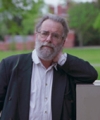
Biography:
Michael Ashburner (1942-) is Emeritus Professor of Biology at the University of Cambridge and is the former Joint-Head of the European Bioinformatics Institute (EBI).
He was educated at the Royal Grammar School, High Wycombe and the University of Cambridge, where he received his undergraduate degree (1964) and Ph.D. (1968), both in genetics. He then went to the California Institute of Technology as a postdoctoral fellow with Hershell Mitchell. In 1979, he returned to the Department of Genetics in Cambridge where he has been based since, as Assistant in Research, University Demonstrator, University Lecturer, Reader in Developmental Biology and Professor (ad hominem) of Biology (since 1991-2011), and now Emeritus (2011-). He has been Miller Professor at the University of California at Berkeley and Visiting Professor at the University of California Medical School, San Francisco; University of Crete, Greece; and University of Pavia, Italy. For the period 1994-2001 he was first Research Coordinator and then Joint-Head of the European Molecular Biology Laboratory - European Bioinformatics Institute at Hinxton, Cambridge. During this period he was on 50% leave from the University of Cambridge.
His major research interests are now the structure and evolution of genomes. Most of his research has been with the model organism Drosophila melanogaster, about which he has written the standard research text (Drosophila: A Laboratory Handbook, Cold Spring Harbor Press, New York, 1989, 2nd ed. 2005). His research has covered a range of subjects, from classical genetics, developmental biology, cytogenetics to evolution, at both molecular and organismal levels. He was a member of the consortium which sequenced the entire genome of this fly (of which he published an account, Won for All: How the Drosophila Genome was Sequenced, Cold Spring Habor Press, New York 2006). He has had a strong interest in the provision of databases for biologists for over 20 years. He was a founder of FlyBase, a major database for researchers using Drosophila as a model organism, a co-founder of the Gene Ontology Consortium (http://www.geneontology.org/), a project to provide infrastructure for biological databases by a defined taxonomy of gene function and of the broader Open Biologocal and Biomedical Ontologies Project (
http://www.obofoundry.org/).
Ashburner is a Fellow of the Royal Society of London and of the Academia Europeae; he is a Foreign Honorary Member of the American Academy of Arts and Sciences, a member of the European Molecular Biology Organization, and past president of the British Genetics Society. He has honorary doctorates from the Universities of Crete and Edinburgh. He has received the Thomas Hunt Morgan Medal and the George Beadle Medal from the Genetics Society of America, the Mendel Medal from the Czech Academy of Sciences, the Genetics Society Medal from the (British) Genetics Society and the Benjamin Franklin Award of the Bioinformatics Organization. He is a Fellow of Churchill College, Cambridge.
Website: http://www.gen.cam.ac.uk/research/ashburner.html
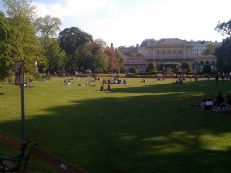 Discover Vienna – Orienteering Ice Breaker
Discover Vienna – Orienteering Ice Breaker 

